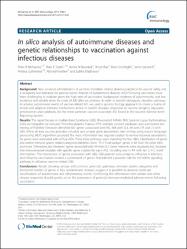In silico analysis of autoimmune diseases and genetic relationships to vaccination against infectious diseases

Göster/
Tarih
2014Yazar
McGarvey, Peter B.Süzek, Barış Ethem
Baraniuk, James N.
Rao, Shruti
Conkright, Brian
Lababidi, Samir
Madhavan, Subha
Üst veri
Tüm öğe kaydını gösterÖzet
Background: Near universal administration of vaccines mandates intense pharmacovigilance for vaccine safety and a stringently low tolerance for adverse events. Reports of autoimmune diseases (AID) following vaccination have been challenging to evaluate given the high rates of vaccination, background incidence of autoimmunity, and low incidence and variable times for onset of AID after vaccinations. In order to identify biologically plausible pathways to adverse autoimmune events of vaccine-related AID, we used a systems biology approach to create a matrix of innate and adaptive immune mechanisms active in specific diseases, responses to vaccine antigens, adjuvants, preservatives and stabilizers, for the most common vaccine-associated AID found in the Vaccine Adverse Event Reporting System. Results: This report focuses on Guillain-Barre Syndrome (GBS), Rheumatoid Arthritis (RA), Systemic Lupus Erythematosus (SLE), and Idiopathic (or immune) Thrombocytopenic Purpura (ITP). Multiple curated databases and automated text mining of PubMed literature identified 667 genes associated with RA, 448 with SLE, 49 with ITP and 73 with GBS. While all data sources provided valuable and unique gene associations, text mining using natural language processing (NLP) algorithms provided the most information but required curation to remove incorrect associations. Six genes were associated with all four AIDs. Thirty-three pathways were shared by the four AIDs. Classification of genes into twelve immune system related categories identified more "Th17T-cell subtype" genes in RA than the other AIDs, and more "Chemokine plus Receptors" genes associated with RA than SLE. Gene networks were visualized and clustered into interconnected modules with specific gene clusters for each AID, including one in RA with ten C-X-C motif chemokines. The intersection of genes associated with GBS, GBS peptide auto-antigens, influenza A infection, and influenza vaccination created a subnetwork of genes that inferred a possible role for the MAPK signaling pathway in influenza vaccine related GBS. Conclusions: Results showing unique and common gene sets, pathways, immune system categories and functional clusters of genes in four autoimmune diseases suggest it is possible to develop molecular classifications of autoimmune and inflammatory events. Combining this information with cellular and other disease responses should greatly aid in the assessment of potential immune- mediated adverse events following vaccination.

















